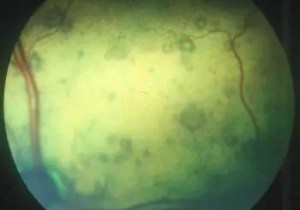[tab name=”The Case”]This cat is presented emaciated at a charity clinic. It has been rescued from a ramshackle farm where the numerous dogs and cats there are fed the same cheap commercial dog food. What is this retinal lesion and can you explain why the cat is suffering from it? [/tab][tab name=”David’s view”]This is a focal area of retinal degeneration dorolateral to the optic disc. This is the area centralis, a region of highly concentrated photoreceptors with consequently a high energy demand. The retinal degeneration is most likely here to be caused by taurine deficiency. Cats require this amino acid while dogs do not, thus a cat fed on a dog food diet will develop lesions such as this retinopathy and cardiomyopathy. The condition was first identified more than a quarter of a century ago (Hayes et al Retinal degeneration associated with taurine deficiency in the cat.
[/tab][tab name=”David’s view”]This is a focal area of retinal degeneration dorolateral to the optic disc. This is the area centralis, a region of highly concentrated photoreceptors with consequently a high energy demand. The retinal degeneration is most likely here to be caused by taurine deficiency. Cats require this amino acid while dogs do not, thus a cat fed on a dog food diet will develop lesions such as this retinopathy and cardiomyopathy. The condition was first identified more than a quarter of a century ago (Hayes et al Retinal degeneration associated with taurine deficiency in the cat.
Science. 1975 188:949-51).
 [/tab][end_tabset]
[/tab][end_tabset]
Topics
- anisocoria
- bird
- blepharitis
- cat
- cataract
- chemosis
- ciliary body adenoma
- conjunctivitis
- corneal epithelial basement membrane dystrophy
- corneal oedema
- corneal opacity
- corneal sequestrum
- Corneal ulcer
- descmetocoele
- distichiasis
- dog
- dry eye
- entropion
- exophthalmos
- eyelid tumour
- Food Animal
- glaucoma
- guinea pig
- Horners syndrome
- Horse
- hypertension
- hypertensive retinopathy
- Iridal cyst
- iris dyscolouration
- Iris melanoma
- keratitis
- Keratoconjunctivitis sicca
- lens luxation
- normal fundus
- progressive retinal atrophy
- rabbit
- reptile
- retinal degeneration
- retinal detachment
- retinopathy
- retrobulbar abscess
- squamous cell carcinoma
- strabismus
- symblepharon
- uveitis
Types of post
- Cases (267)
- David's Blog (3)
- news (2)
- pages (1)
- Publications (8)
-
Recent Posts
















You must be logged in to post a comment.